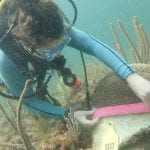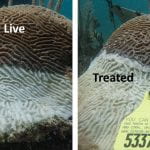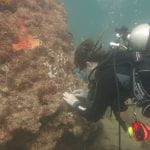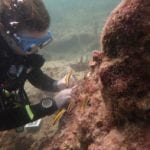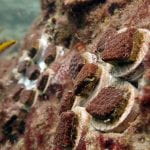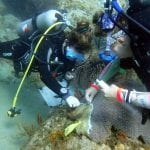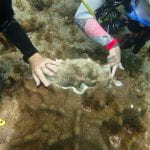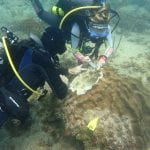Extreme Temperature Stress is Proving Disastrous For
Southeast Florida’s Coral Reefs
FORT LAUDERDALE/DAVIE, Fla. – Florida’s coral reefs are struggling. Like, really struggling.
We’ve all seen the stories about how coral reefs, thanks to the extremely high water temperatures, are experiencing a bleaching event like never before. But what you HAVEN’T seen, and what Nova Southeastern University (NSU) researcher scientists are racing to address, is how these high temps have accelerated a deadly disease that has been threatening corals for years.
Since 2018 in Southeast Florida, researchers at NSU’s GIS and Spatial Ecology Lab have been working to address one of these stressors – SCTLD. This disease causes lesions that move quickly across affected coral colonies, often killing them within weeks. Now, thanks to the extreme temperatures our area has been experiencing, over the past few weeks, the number of diseased corals has skyrocketed. Since May, researchers treated 331 corals of 12 species in Broward and Miami-Dade counties. This is more than the total yearly treatments in any year prior, in just three months.
“We had the most diseased large corals last summer than any previous year, and this year looks to be much worse,” says Brian Walker, Ph.D., research program director, NSU’s GIS & Spatial Ecology Laboratory in the Halmos College of Arts and Sciences. In June, the team treated more lesions than any previous June. The number of treatments and the number of corals treated in July was the third highest since monitoring began. And August was the highest yet.
The recent heat wave has increased local Florida water temperatures, causing a massive bleaching event throughout the Florida Keys. In the extremely warm waters, corals are losing their symbiotic algae that provide them essential nutrition, a condition that causes death in prolonged heat. As the heat continues, some corals are starting to bleach in southeast Florida. Making matters worse, SCTLD is thought to be related to the symbiotic algae and its spread is exacerbated by high temperatures.
A research team led by Walker recently found that four years of temperature, rainfall, and inlet flow data explained 66% of the variation in the number of corals with lesions. Similar models of reef water quality sites found that inlet flow, rainfall, and wind predictors explained 79% of the variation in orthophosphates and 55% of nitrates. This suggests that SCTLD is exacerbated seasonally by excessive nutrients during increased rainfall and inlet flow rates during high temperature periods.
So far, 2023 has proven to be an exceptional year in both having an early rainy season and an extreme unprecedented heatwave. According to the South Florida Water Management District, rainfall in Broward was over 300% above average in April, followed by reports from the National Oceanographic and Atmospheric Administration showing the highest ocean temperatures ever recorded in the Florida Keys.
“We typically see increases in coral disease every year that coincide with the onset of the rainy, summer season between May and October where the number of lesions and diseased corals increases, but never like this year,” said Walker. “This year’s combination of high rainfall and extreme temperatures is proving to be disastrous for corals in South Florida.”
Every month since 2018, the GIS and Spatial Ecology Lab monitors and treats disease on over 100 of the largest, oldest, most resilient colonies in southeast Florida. Saving these reef-building corals is a priority because they have a higher reproductive potential, increasing the natural ability to replenish the reef and their size provides reef structure and habitats for many organisms. Researchers are using a highly effective antibiotic paste called CoralCure to smother on the disease lesion and, in some cases, create a disease-break, a small trench cut into the about 5 cm from the visibly diseased margin using a underwater grinder to isolate the visually diseased portion from the rest of the colony.
This work is permitted by the Florida Fish and Wildlife Conservation Commission and funded by Florida’s Department of Environmental Protection, National Fish and Wildlife Foundation, and US Environmental Protection Agency.
- Credit: NSU GIS/Spatial Ecology Lab
- Credit: NSU GIS/Spatial Ecology Lab
- Credit: NSU GIS/Spatial Ecology Lab
- Credit: NSU GIS/Spatial Ecology Lab
- Credit: NSU GIS/Spatial Ecology Lab
- Credit: NSU GIS/Spatial Ecology Lab
- Credit: NSU GIS/Spatial Ecology Lab
- Credit: NSU GIS/Spatial Ecology Lab
These corals are too large to move to onshore coral nurseries to escape the heat. However, Dr. Walker’s team has collected many pieces of these corals that were broken off by other activities like anchoring, storm damage and divers to use in restoring the large corals. These fragments were then brought to NSU’s onshore coral nursery, where they remain until they can be “outplanted’ back on the reef. That restoration is now on hold as the team ramps up efforts to find and treat as many diseased corals as possible.
“It’s really a two-pronged effort to help,” said Dr. Walker. “First, when possible, fragments are saved and cared for, with the goal of returning them to the reed. Second, we’re working tirelessly to treat diseased corals to help stop the spread of the disease and provide help so the reef can recover.”
Dr. Walker says that South Florida residents can play a part in saving our corals, too.
To help, if anyone comes across diseased coral, they can go online and report any of these locations to The Southeast Florida Action Network (SEAFAN) or call the SEAFAN hotline at 866-770-SEFL (7335).
Be sure to sign up for NSU’s RSS feed so you don’t miss any of our news releases, guest editorials and other announcements. Please sign up HERE. You can also follow us on Twitter @NSUNews.
###
About Nova Southeastern University (NSU): At NSU, students don’t just get an education, they get the competitive edge they need for real careers, real contributions and real life. A dynamic, private research university, NSU is providing high-quality educational and research programs at the undergraduate, graduate, and professional degree levels. Established in 1964, the university includes 14 colleges, the “theme park” for start-ups, scale-ups , and entrepreneurs, the Alan B. Levan | NSU Broward Center of Innovation, the 215,000-square-foot Center for Collaborative Research, the private PK1-12 grade University School, the world-class NSU Art Museum Fort Lauderdale, and the Alvin Sherman Library, Research and Information Technology Center, one of Florida’s largest public libraries. NSU students learn at our campuses in Fort Lauderdale, Fort Myers, Jacksonville, Miami, Miramar, Orlando, Palm Beach, and Tampa, Florida, as well as San Juan, Puerto Rico, and online globally. With more than 200,000 alumni across the globe, the reach of the NSU community is worldwide. Classified as having “high research activity” by the Carnegie Foundation for the Advancement of Teaching, NSU is one of only 59 universities nationwide to also be awarded Carnegie’s Community Engagement Classification, and is also the largest private institution in the United States that meets the U.S. Department of Education’s criteria as a Hispanic-serving Institution. Please visit www.nova.edu for more information.
About Brian K. Walker, Ph.D.: Uses Geographic Information Systems (GIS) to study the ecology, distribution, and spatial arrangement of marine fish and benthic (sea bottom) organisms for advancing scientific knowledge, resource management, and conservation. Leads the SCTLD resistance research consortium to understand the genetic, biochemical, and physiological underpinnings of SCTLD resistance to characterize factors that are driving differences in disease susceptibility. Leads the Kristen Jacobs’ Coral Reef Ecosystem Conservation Area SCTLD interventions. Weblink to FWC’s Coral Disease Intervention Dashboard and the GIS and Spatial Ecology lab’s Coral Disease Intervention Storymap
MEDIA CONTACT
Joe Donzelli, APR | Office of Media Relations
Nova Southeastern University
954-262-2159 (office)
jdonzelli@nova.edu | www.nova.edu | @NSU_Joe
